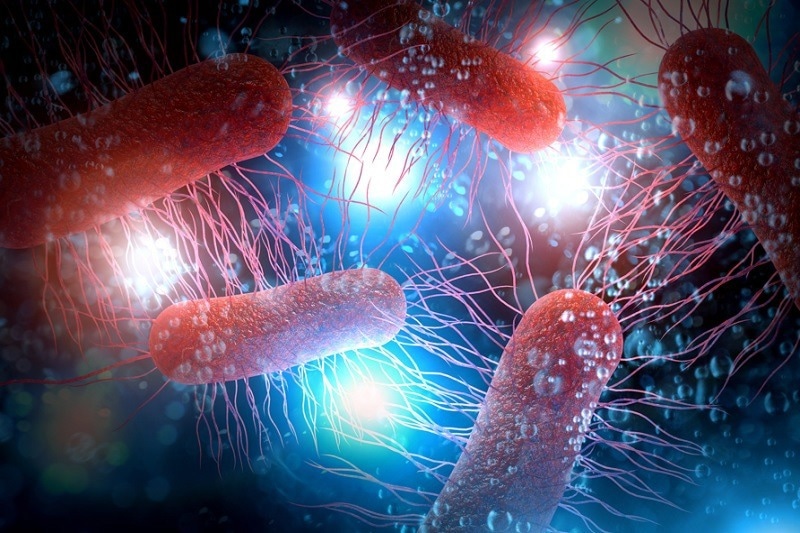A report from Birmingham researchers that was published in Materials Horizons describes a novel technique for improving biocatalysis efficiency.
 E. coli strain MC4100 is known to be poor at forming biofilms. The researchers monitored the biomass and biocatalytic activity of MC4100 and E. coli strain PHL644 (a good biofilm former) incubated in the presence of the polymers. They found MC4100 matched and even outperformed PHL644. Image Credit: University of Birmingham.
E. coli strain MC4100 is known to be poor at forming biofilms. The researchers monitored the biomass and biocatalytic activity of MC4100 and E. coli strain PHL644 (a good biofilm former) incubated in the presence of the polymers. They found MC4100 matched and even outperformed PHL644. Image Credit: University of Birmingham.
To create goods that cannot be produced through chemical synthesis, biocatalysis uses enzymes, organisms, or microbes to catalyze chemical processes in sectors like food and chemical ones. On a large scale, it can create medications, fine chemicals, or food additives.
The fact that the most frequently used microbes, such as probiotics and non-pathogenic strains of Escherichia coli, are not always adept at forming biofilms—growth-promoting ecosystems that create a protective microenvironment around communities of microbes, boost their resilience, and thereby increase productivity—represents a significant challenge in biocatalysis.
Researchers Dr Tim Overton from the university’s School of Chemical Engineering and Dr Francisco Fernández Trillo from the School of Chemistry, members of the Institute of Microbiology and Infection, set out to develop an alternate method to avoid this expensive and time-consuming procedure.
The E. coli bacterium, one of the most extensively studied microorganisms, is frequently utilized in biocatalysis. The researchers discovered a library of synthetic polymers and evaluated them for their capacity to cause biofilm development in E. coli.
In this screening, an E. coli strain (MC4100) that is frequently used in basic science to investigate genes and proteins and is known to be inefficient at generating biofilms was compared to an isogenic, evolved E. coli strain (PHL644) that is strong at creating biofilms.
The chemicals that are most effective at promoting biofilm development were identified through this screening. Mildly cationic polymers were surpassed by hydrophobic polymers, while the comparable aliphatic polymers were significantly outperformed by aromatic and heteroaromatic derivatives.
When both strains were cultured in the presence of these polymers, the researchers continued to monitor their biomass and biocatalytic activity and discovered that MC4100 was on par with PHL644 in both areas.
Additional research looked into how the polymers induced these significant increases in activity. In this case, the research showed that the polymers precipitate in solution and function as coagulants, causing flocculation, a natural process that causes bacteria to build biofilms, to be stimulated.
We explored a broad chemical space and identified the best performing chemistries and polymers that increase the biocatalytic activity of E. coli, a workhorse in biotechnology. This has resulted in a small library of synthetic polymers that increase biofilm formation when used as simple additives to microbial culture.”
Dr Fernandez-Trillo, School of Chemistry, University of Birmingham
Dr Fernandez-Trillo adds, “To the best of our knowledge, currently there are no methods that provide this simplicity and versatility when promoting biofilms for beneficial bacteria.”
These synthetic polymers may bypass the need to introduce the traits for biofilm formation through gene editing, which is costly, time-consuming, non-reversible and requires a skilled person in microbiology to implement it.”
Dr Fernandez-Trillo, School of Chemistry, University of Birmingham
“We believe this approach has an impact beyond biofilms for biocatalysis. A similar strategy could be employed to identify candidate polymers for other microorganisms such as probiotics or yeasts, and develop new applications in food science, agriculture, bioremediation or health,” concludes Dr Fernandez-Trillo.
The University of Birmingham Enterprise has filed a patent application for the technique and polymer additives and is now looking for business partners for licensing.
Source:
Journal reference:
Adoni, P., et al. (2022) Polymer-induced biofilms for enhanced biocatalysis. Materials Horizons. doi.org/10.1039/D2MH00607C.